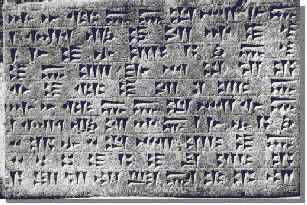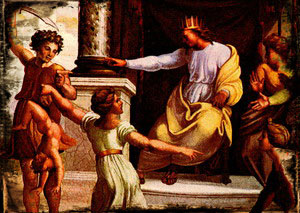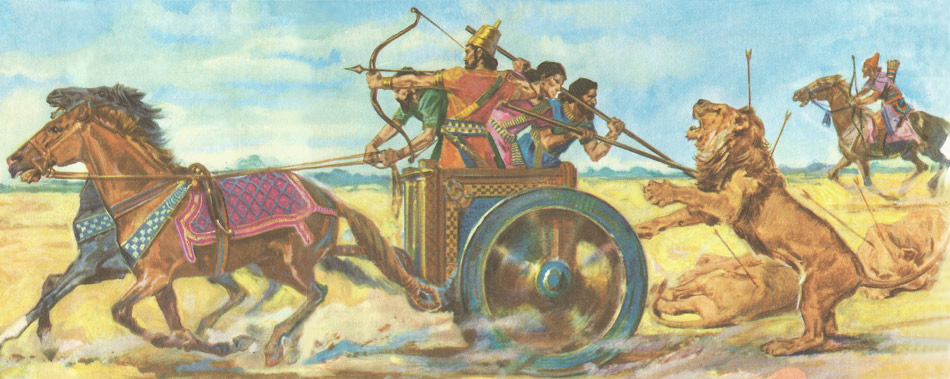1316-1313 BCE
Wooden figurines depicting Nubian archers. From a royal grave dating back to the Eleventh Dynasty.
After a short era of retreat caused by the Amarna succession wars and other internal strife, Egypt managed to restore its focus in the Canaan. Egyptian garrisons in the core cities were quickly rebuilt, the necessary manpower attracted with massive campaigns in Egypt, often aided by the Atenist clergy. No more could Smenkhaten rely on further bands of Medjay or Kushites in general, so for the first time in a decent amount of time the core of the Egyptian policing force in the Canaan were native Egyptians, not vassals or unreliable mercenaries. Defending the prestige of the godlike Pharaoh and Atenist religion from enemies both within and outside was regarded as a pious task by many of the more fanatic supporters of the new religious policy. Thus the age of chaos in the land of Retenu came to a slow end, with the cities and towns slowly recovering from the raids of the pirates and Semitic nomads. Restoration in the region was also aided by a heavy Egyptian investment to local trade, as Egyptian vessels became a more common sight in all the cities from Gaza to Tyre, bringing in valuable goods and repairing crucial trade links. Furthermore a heavier presence of Egyptian warships and garrisons served to discourage any further pirate adventurers from Alashiya, albeit the Pharaoh also sent traders and envoys to this island of Atate.
[Trade income boost to Egypt next turn, socioeconomic situation in the Canaan slowly improving]
There was however a new source of threats, or maybe rather a resurgent one, to the Atenist establishment. In the south the hereditary viceroy of Kush, Amenhotep-Huy, had been making more and more independent moves over the past decade, questioning the actual nature of the relationship between him and Akhetaten. The truce negotiated during the War of Amarna Succession was certainly questioned when news reached the north of a mobilization and strengthening of garrisons and armies in the land of Kush. With a rapid advance due to a lack in population and effective fortresses, the warriors recently employed by the Viceroy smashed northwards, seizing large swatches of the part of Lower Nubia still under the control of the Pharaoh. After these quick and almost bloodless victories, Amenhotep declared himself King of Kush in his own right, this was in the summer of 1314. A similar declaration had been given in Kush earlier during the Amarna war, but rescinded and forfeited in the interests of peace. Now however, Amenhotep and the Kushites had seemingly had enough time to build up and prepare for a proper conflict, as opposed to the skirmishes that had been fought with them and Atenists earlier. With Kush and especially its partly Egyptian elite still ardently favoring the traditional gods, Amenhotep found a very easy way to rally his people for a renewed war. If the resources of Kush were enough to actually challenge the strong Atenist position in Upper Egypt was however quite questionable, as proven by the lack of proper advance past the first cataract. The response from the Pharaoh came the next year, with the new divisions staffed with Atenist faithful marching south down the Nile, seizing back a portion of Nubia but failing to dislodge the Kushites from all the towns and fortresses seized, mainly due to a hostile environment, poor knowledge of the region and difficulties in supplying the army. In 1313 a detachment of the Army of the Sun managed to reach the first cataract, but was encircled and devastatingly smashed by the Kushites who then proceeded to once again reoccupy large portions of northern Lower Nubia.
[Kush and Egypt at war]
A peace in the west would be remembered as last of Šuppiluliuma’s great feats of warfare and diplomacy, culminating the restoration of Hittite might in all corners of Anatolia and northern Levant. From his deathbed the Great King dictated the peace terms of the new order in the west, assigning Manapa-Tarhunta and Maskhuiluwa as vassal kings and allocating to them some Arzawan territory in return for tribute and gifts expected of vassalage. The core of Arzawa remained in the hands of Uhha-Ziti, albeit considerable territory was annexed into the Hittite province of Happalla. Spoils were divided and gifts sent to the Hittite allies and subjects who took part in the battles, and small Hittite garrisons deployed in the region to ensure a lasting peace. The retreat of the main army and the fact that Arzawa wasn’t entirely razed off the map somewhat improved the tense relations with the Ahhiyawans, who were now busy fighting the rising Alashiyan threat. In fact the Ahhiyawan colonists of Millawanda sent a delegation to Hattusa to greet the Great King with gifts, but great Šuppiluliuma had passed away by then, in the summer of 1316.
[Peace in the West, slight improvement to relations with Ahhiyawa, Seha and Mira new vassal territories]
The succession was a carefully prepared and peaceful matter, as none of the sons or generals of the Great King wanted to upset his legacy, and thus honored the wills and degrees issued by Šuppiluliuma in his last months on the throne. Arnuwanda II, having acquired strong experience as the ruler of Halab and the Syrian territories, succeeded his father in a lavish ceremony following the burial. The Syrian provinces were restructured; Piyaššili the second son was given the viceroyalty of Halab, the third son Muršili Carchemish and finally the most junior one, Zannanza, Ugarit. The splitting of the region eased administration, while also offered each prince less resources for a possible attempt at usurpation. Of these three only Piyaššili ruled in his own right, while the other and more inexperienced princes were in fact mostly under the influence of regional officials and Hittite military officers. With the Hittite military retaining its might and with Arnuwanda II recognized as a potent and powerful leader, almost equal to his father, there were little signs of sedition or rebellion. In 1314 and 1313 there were minor disturbances in the Pala and Kaska lands, caused originally by tribal infighting and disputes over cattle herds, but a quick military expedition quelled them. How long the subject peoples and foreign foes would respect and recognize the powerful legacy of Šuppiluliuma I however still remained to be seen.
[Arnuwanda II succeeds Šuppiluliuma I, restructuring in Syria, stability and peace retained so far, Hittite stability at stable]
The next move of the Babylonians was to try a diplomatic game to overcome the difficulties caused by the stiff resistance of the Hurrians of Arrapha. Kara-ḫardaš sent envoys to the city, offering marriages and freedom from Assyrian and Babylonian rule if the city casted out the Assyrian dignitaries and declared independence in its own right. After an exchange of bribes and under a threat of a renewed attack with the full might of the Kassite army, the city’s priests and king agreed. A coalition of Arraphans and Kassites marched on the crucial city of Arbail, also inhabited by Hurrians, and managed to seize it after a long siege in late 1316. The Babylonians were now in a very good position to advance into Nineveh and the surrounding plains, threatening to put an end to the nascent Assyrian independence. Doubts were cast upon the leadership of Arik-den-ili I, who resorted to ordering massive sacrifices in a desperate attempt to gain the favor of the gods in the face of an almost certain doom. But these prayers and offerings to Aššur the Great would be answered.
With the Kassite military scrambling for its spring campaign in 1315, Kidin-Hutran of Haltamti, who had bid his time for a few years now, decided to make his decisive move. Claiming that Kara-ḫardaš was illegitimate, and citing his Kassite descent by his mother, a daughter of Burna-Buriaš, Kidin-Hutran presented himself as the legitimate king of Karduniaš. He had some support of Babylonian exiles that had backed Kurigalzu too deeply, even though the exiled Elamite-linked prince wasn’t in a position to act in support. The Elamite warbands assembled and crossed into Kassite territory, with bands quickly pushing to the Tigris river. However, these movements that alerted the main Kassite garrisons of the south were a mere distraction. The main Elamite push was aimed at the land of Namri and conducted with experienced vassal troops of the East, along with local tribes. The Elamites seized the city of Halman by surprise and quickly swooped in down the river Diyala, securing an easy route of invasion through the mountainous passes and circumventing Kassite strongholds in Sumeria. In this more mountainous terrain and rugged ground the advantage of the Kassite chariot was quite well nullified, making attempts to counterattack fail, despite of the lighter and smaller composition of the armies of the Haltamti.
[Elam invades Babylonia]
The entrance of Elam to the war, unlike the past one this time against the Babylonians, gave Assyria a significant relief. From near total brink they swooped into new victories, at first marching quickly against Arrapha, and forcing the Hurrian leaders of the city to denounce their ties to Babylon. In a coup the pro-Babylonian royal family was ousted and a new one linked dynastically to Assyria installed. With a total collapse seemingly apparent in Kassite defenses along the Diyala River, the Babylonians were forced to abandon Aššur in late 1315, hastily built fortifications which required huge effort and resources left behind. Not wasting time to lament the destruction and depopulation brought upon their capital city, the vengeful Assyrians marched further south, forcing the Babylonians to abandon most of their forts and towns north of the previous border. In 1314 the Kassites managed to stop an advance by the Elamites further down the river Diyala, defeating Kidin-Hutran at the battle of Meturna. Nevertheless Halman remained occupied by the Elamites, very much threatening any further campaign against Assyria before the force could be dislodged. In the south Elamite armies occupied the sparsely populated and poor regions of Gambulu and Yamutbal east of the Tigris, but failed to take any meaningful cities or actually rich and vital regions of Babylonia proper. An attack towards Esnunna from southwest was beaten off with heavy casualties to the Elamites, allowing the Kassites time to rebuild a formidable host of troops. Assyrians in the north managed to launch a powerful attack on Kar-Ištar, once again seizing the city due to tacit aid from Elamite armies keeping the Kassites occupied. The attrition caused by fighting two enemies at the same time was however getting rather costly for Karduniaš, despite of the defeat of the initial Elamite invasion attempts of her core regions. The Elamite rear, on the other hand, was harassed by the warriors of Zamua and Gutium, but with the Zamuans too few in manpower and the Gutians in a state of decay, this didn’t amount to much, apart for tying up a crucial part of the Elamite military to allow the Babylonians to prevent them from reaching the Tigris in the north.
[Assyrian incomes restored, 50 % chance of stability hit to Babylonia next turn, trade income loss to Elam and Babylonia]
Shuttarna III proved out to be a far more active ruler than his father Artatama II, who had mostly resigned from public after assuming the throne with the help of Hittite arms and did only a few large construction projects or declarations. Shuttarna III however, almost immediately begun to reintroduce and reinforce the reforms and changes begun during the era before Hittite takeover. The question, of course, was how much control the king had over these events, as seemingly a certain court clique, consisting of both Hittite officers and most loyal Mitannian nobles and most brave mariyannu warriors rose into prominence. Most importantly the bureaucratic reforms aimed at restoring provincial administration that was still in shambles was pushed forward by the new king. This along with the recovering trade in Hittite territories west of the Euphrates, as well as a general stability and peace in the vast countryside, allowed the land of Mitanni to continue its slow recovery. The Mitannians also conducted a short campaign in the northern region, forcing back the Išuwan exiles, despite of some of his courtiers arguing for the usefulness of these Hurrian tribesmen if employed as troops or frontier guards. Nevertheless, they were dispersed to the desolate regions now owned by Hayasa-Azzi, or to Hurrian land of Alshe and Nihriya.
[Mitanni tax income set at Mid, royal income to Mid in two turns, 50 % chance of stability boost next turn]
The Alashiyans decided to answer back to the Ahhiyawans in a similar way. In a show of force a grand fleet of Alashiyan warships set sail for Kaptara, or Keftiu as known to the Egyptians. The navy embarked off the shore of the old palatial site of Dikta in the western part of the island, and by 1314 an Alashiyan colony had been founded at the city, with the local Minoan citizens subjugated to Alashiyan rule. This further bolstered Alashiyan standing on the island, allowing them to further expand their influence over the principal trading hub of Konoso, as well as on other sites. With a swift series of naval expeditions, aided by locals, Alashiyans managed to almost completely eradicate the traditionally heavy Ahhiyawan presence and influence on the island. Needless to say, a response was swift, and all Alashiyan shipping venturing too close to the islands of the Ahhiyawans came under brutal attack. To bolster his forces, King Anamika gave a decree ordering that taxes, tributes and dues could now also be paid by having men serving in the Alashiyan armies, an offer extending to various subject peoples of the island. This provided Anamika with a considerable force to use against the Ahhiyawans, both on seas and the contested island. Another front of this struggle for influence opened up in the Hittite vassal principality of Wilusa, but due to an intervention from Hattusa Prince Ilu refrained from taking a side, as after all Hittite relations were sour with both actors.
[Alashiya and Ahhiyawans (yes Mycenaeans) at war]















